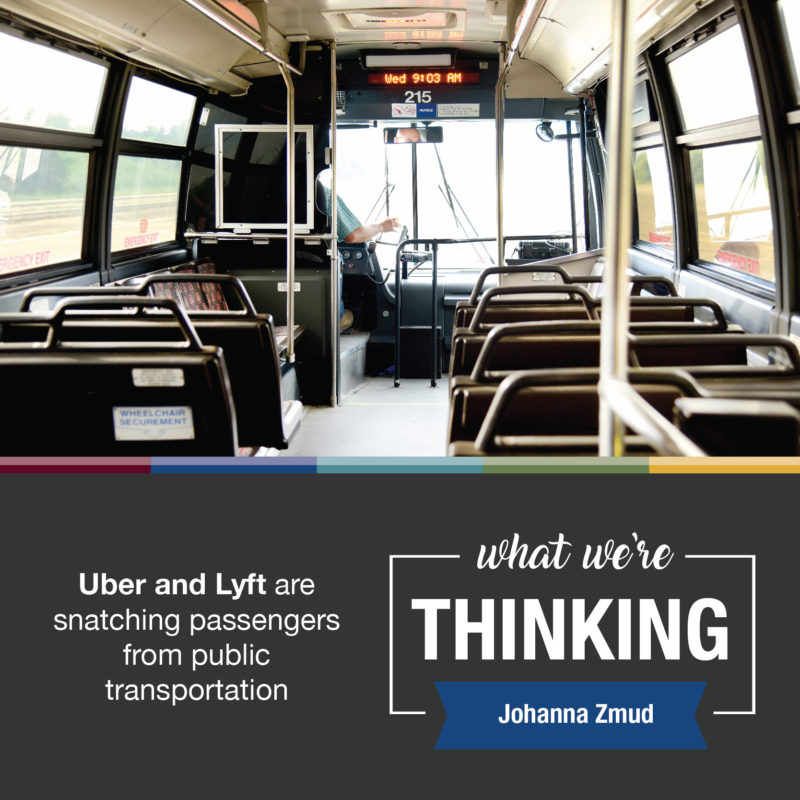Transportation Network Companies (TNCs) are putting a dent in public transit use. And that matters to you, even if you never hail a car or board a bus.
TNCs have been an established fixture in urban transportation landscapes for only a few years, so their impacts on other mobility modes have been inconclusive up to now. We simply haven’t had sufficient data to gauge those impacts. But that’s changing. The evidence is accumulating, and the indicators are emerging: ride-sourcing is contributing to a decline in public transportation use.
Some 70 percent of TNC trips happen in the nation’s largest metro areas. Those areas also represent the largest public transit markets, and virtually all – including Dallas – have seen transit ridership dwindle since 2016. Multiple studies over the past two years point to more examples of people choosing ride-sourcing as a substitute for public transit.
The trend has implications on both institutional and personal levels.
What this means for cities.
As transit ridership declines, so goes fare revenue, pushing an operating agency to respond in one of two ways: 1) Bring service levels in line with reduced funding by dropping less-utilized routes and/or trimming route frequency, or 2) compensate for the revenue dip by raising fares or boosting tax subsidies. Service cutbacks and fare hikes, however, can then lead to even fewer people taking buses and trains, potentially triggering still more service reductions, and producing a downward spiraling effect that’s eventually impossible to reverse.
A city is a lot like a human body. Without exercise, without mobility, that human body is at risk of atrophy, with muscles and organs in danger of losing their vibrant quality and purpose. A city is also a living thing. Remove a major means of mobility – hamper an urban area’s ability to flex its economic muscles – and an otherwise healthy city is in similar danger of wasting away.
What this means for people.
As TNCs shift travelers away from space-efficient modes (not only public transit, but also walking or biking), the result is higher levels of VMT – vehicle miles traveled – one of the metrics used to quantify traffic congestion. TNCs do offer split rides (in which a single ride is shared by at least two people) but that option is rarely used. It’s simple math: More travelers + more cars = more gridlock, and more personal time forever lost.
More vehicles idling in gridlock also produce more tailpipe emissions, further fouling the air that all of us breathe. When public transit ridership suffers, so does public health.
And of course, reduced transit service levels mean fewer mobility options for those who most need them, in some cases jeopardizing their ability to hold a job get to a medical appointment, or remain mobile with a physical disability.
Trade-offs.
TNCs’ impacts on urban transportation aren’t all negative, of course. Quite the contrary, in fact. Uber and Lyft and their many competitors have transformed mobility, introducing a highly successful and appealing option for many of us (even if not profitable for investors thus far).
At the same time, that option has been highly disruptive in some ways. Consider, for example, what TNCs have done to the taxi business. In response, New York in August became the first city to cap the number of licensed TNC vehicles, impose a minimum wage for drivers, and require more data sharing by the companies – all in the interest of leveling the playing field for a taxi industry that’s been struggling as ride-sharing gobbles up market share.
Will other cities follow New York’s lead? Or, given what we know now, will cities pursue regulations that are friendly to transportation network companies and also help public transportation remain viable? We don’t yet know.
What we do know is that alternative modes, whether transportation network companies or others, are certainly needed. What’s also needed is a policy approach that ensures a balance of benefits and trade-offs that faithfully serve the public’s interest.
Policy needs to be built upon wise insight drawn from reliable information. We need to more clearly understand current trends in vehicle ownership, vehicle usage, mode choice, and travel volumes, given the emerging transportation developments.
And with better understanding and forecasting, we can make better public policy to address emerging challenges.
Johanna Zmud is a Senior Research Scientist at the Texas A&M Transportation Institute.
This article was originally published in Dallas News, September 28, 2018.
